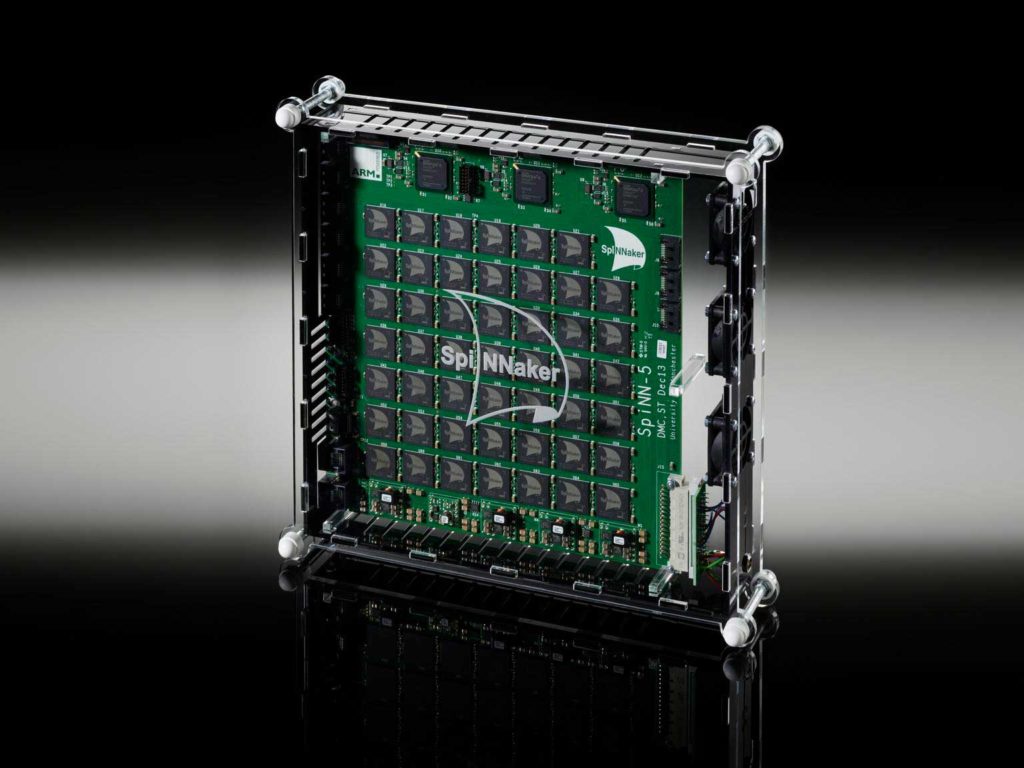It was at the University of Manchester that ’Baby’ ran the world’s first computer programme stored in memory, on 21 June 1948. It was in the Moston Ferranti factory that the world’s first commercially available computer, the Ferranti Mark 1 was produced in 1951, and during the 1980s, the ARM chips that power smartphones around the world were co-designed by a Mancunian. Manchester really is a city of computing.
Manchester continues to make world-class, innovative computer hardware, and in 2018, it became home to the world’s largest neuromorphic supercomputer, the million-core SpiNNaker machine.
SpiNNaker is modelled on the human brain and designed to mimic the way neurons in our brain send information through electrochemical ‘spikes’. This is reflected in the computer’s name, Spiking Neural Network Architecture—SpiNNaker.
SpiNNaker is Manchester’s contribution to the Human Brain Project, a €607 million project launched in 2013 and co-funded by the European Union. The project is made possible by over 500 researchers in 16 countries.
This year we have added one small but vitally important component of the massive SpiNNaker computer to our permanent collection at the Science and Industry Museum. The 48-node SpiNNaker board could be used on its own to develop software and do very small-scale neural network simulations of the human brain. The SpiNNaker supercomputer at the University of Manchester contains 1,200 of these boards.

Science Museum Group © The Board of Trustees of the Science Museum
The node board will be on display at this year’s Manchester Science Festival, marking the first time an element of the SpiNNaker has been available for the public to view, before going on long-term display in our Revolution Manchester gallery.
SpiNNaker has been used to improve safety in working spaces where robots and humans work alongside each other by helping Artificial Intelligence to see like a human and identify the dangers in the workspace.
Scientists have also used SpiNNaker to model a human brain’s Basal Ganglia structure. Knowing more about this part of the brain could help us better understand degenerative disorders like Parkinson’s disease.
The team of computer scientists who built the SpiNNaker specialise in constructing new computer architectures from the bottom up. They first designed the SpiNNaker chip before scaling-up to make the SpiNNaker1M supercomputer. The group is led by Steve Furber, who, with Sophie Wilson, designed the ARM processors that are now in most mobile phones.
The idea of a ’computer as a brain’ has a history that stretches back at least into the 19th century, with Charles Babbage, Ada Lovelace and the Analytical Engine. As historian Jon Agar noted, humans have been making (crude) models of the human brain from electronic hardware since the Second World War. While at the University of Manchester, Alan Turing wrote On Computing Machinery and Intelligence in 1950, in which he proposed a game to see if a computer could imitate human intelligence. This has since become known as the ’Turing test’. Turing predicted that by the 21st century, computers would have at least 1 billion bytes of memory (or one gigabyte) and would be able to pass his test.
Turing was right in his predictions for computer memory size. However, as Steve Furber has noted, for a computer to pass the Turing test, it requires more than just increasing memory size. The laptop I’m writing on has 8 gigabytes of RAM (Random-Access Memory), compared to Baby’s 128 bytes of RAM, but it would not pass the Turing test.
As Furber himself has acknowledged, ’we still do not understand natural intelligence, so we do not know exactly what it is we are trying to reproduce in our machines’. If we do not understand human intelligence, won’t our attempts to create human-like intelligence in machines be fruitless? Indeed, the Human Brian Project attracted strong criticism from the European neuroscience community in 2014 for being too much about hunting for new computer architectures, while neglecting to focus on a better understanding of how the human brain works.
The SpiNNaker group’s ambitious target was to simulate a billion neurons with their supercomputer. SpiNNaker marked two decades worth of work for hundreds of people. They succeeded in modelling the neural networks of a mouse brain (around 70 million neurons) in biological real time. Current evidence suggests our brains have 86 billion neurons. Steve Furber has acknowledged that ’there is still a long way to go to deliver a real-time model of a full human brain’, but The Baby computer, which inspired all subsequent progress in computing, only had 128 bytes of memory, proving everything has to start somewhere.